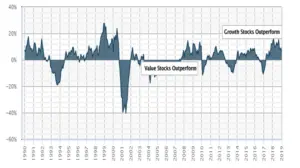Growth vs. Value: Two Approaches to Stock Investing
Growth vs. Value: Two Approaches to Stock Investing
For growth stock investors, it’s been a heady time. Growth stocks recorded a total return of 33.5% for the year ended December 31, 2020, significantly eclipsing value’s 1.4% showing. And over the past five years, growth has outperformed value by an average of over 8 percentage points.1
Does this mean that value investors should rethink their strategy? Probably not. As history has shown, leadership between growth and value tends to shift back and forth, depending on the stage of the market and economic cycle. Which of the two outperforms the other is ultimately attributable to their fundamental characteristics.
Growth and Value Defined
Growth stocks represent companies that have demonstrated better-than-average gains in earnings in recent years and that have the potential to continue delivering high levels of profit growth.
Key characteristics of growth funds include:
- Higher prices than the broader market. Investors are typically willing to pay high price-to-earnings multiples with the expectation of selling shares at even higher prices as the companies continue to grow.
- High earnings growth records. While the earnings of some companies may be depressed during periods of slower economic improvement, growth companies may have the potential to achieve high earnings growth in different economic environments.
- More volatile than the broader market. The risk in buying a given growth stock is that its lofty price could fall sharply on any negative news about the company, particularly if earnings disappoint on Wall Street.
Value fund managers look for companies that have fallen out of favor but still have good fundamentals. The value group may also include stocks of new companies that have yet to be discovered by investors.
Key characteristics of value funds include:
- Lower prices than the broader market. The idea behind value investing is that stocks of good companies will bounce back in time if and when their true value is recognized by other investors.
- Priced below similar companies in their industry. Many value investors believe that a majority of value stocks are created due to investors’ overreacting to recent company problems, such as disappointing earnings, negative publicity, or legal problems, all of which may raise doubts about the company’s long-term prospects.
- Somewhat less risk carried than the broader market. However, as they take time to turn around, value stocks may carry more risk of price fluctuation than growth stocks.
Growth or Value… or Both?
Which strategy — growth or value — is likely to produce higher returns over the long term? The battle between growth and value investing has been going on for years, with no definitive winner. History shows us that growth stocks, in general, have the potential to perform better when interest rates are falling and company earnings are rising. However, they may also be the first to be punished when the economy is cooling. Value stocks, often stocks of cyclical industries, may do well early in an economic recovery but are typically more likely to lag in a sustained bull market.
Growth vs. Value Take Turns (2)
For long-term investors, a balanced approach may be most appropriate. Combining both growth and value stocks, or stock funds, may allow you to take advantage of different economic cycles and smooth out returns over time. Talk to your financial professional to see how you might best position your portfolio.
Notes:
1Source: DST Retirement Solutions, LLC, an SS&C company. Based on total returns of the S&P 500 Growth and Value indexes.
2Source: ChartSource®, DST Retirement Solutions, LLC, an SS&C company. Based on 12-month rolling returns from 1990 to 2019. Growth and value stocks are represented by composites of the S&P 500/Barra Growth and Value indexes and the S&P 500 Growth and Value indexes, which are unmanaged indexes generally considered representative of growth and value large-cap stocks. It is not possible to invest directly in an index. Index performance does not reflect the effects of investing costs and taxes. Actual results would vary from benchmarks and would likely have been lower. Stock investing involves risk, including loss of principal. Past performance is not a guarantee of future results. (CS000047)
Investing in mutual funds involves risk, including loss of principal.
This material was prepared by LPL Financial. This material is for general information only and is not intended to provide specific advice or recommendations for any individual. There is no assurance that they views or strategies discussed are suitable for all investors or will yield positive outcomes. Investing involves risks including possible loss of principal. Any economic forecasts set forth may not develop as predicted and are subject to change. All performance referenced is historical and is no guarantee of future results.






Leave a Reply
Want to join the discussion?Feel free to contribute!